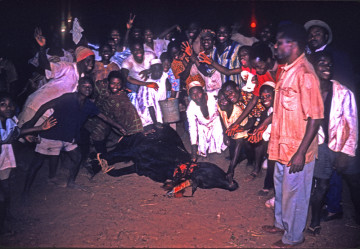[Note: Click on any image you may want to enlarge.]
1. First, Onyejekwe is Painted with white clay (Ima-Nzu)
By the time I reach Onyejekwe’s compound in Ogbe-Ozala after the November 19th Mass Meeting, his Painting with white clay has already been performed. The Senior Priest of Umu-Chima-Ogbuefi, Nnanyelugo Melifonwu, is present, but I am told that the aspirant’s senior brother B.C. Akosa did the actual Painting in his capacity as senior lineage priest of Orowa Family. Many young men and women stroll about the nearby village square, while within the Ancestral House Onyejekwe sits on his throne as various supporters enter, bow, and touch their heads on the altar, saluting him as “Sky.”
2. The newspapers respond
Obiekwe Aniweta sends his letter of protest to the senior chiefs and officials of the Regional Government, and on November 21 it is published in both the Eastern Observer and the Nigerian Spokesman:
“Sirs,
I have been directed by the Onitsha Aborigines Association to inform you that the meeting convened by you today is traditionally illegal and unconstitutional. You will understand that in the absence of the King i.e. Obi of Onitsha the next person in authority is invariably the Onowu of Onitsha, at present Chief P.O. Anatogu.
The Onitsha Aborigines Association, a cultural organisation for protecting the traditions, customs and native laws of Onitsha feels that your action in this connection is tantamount to usurpation of the power of the Prime Minister of Onitsha and a deliberate attempt on your part to do violence to Onitsha customs and traditions.
Furthermore, it has been brought to our notice that Chief J.O. Mbamali, Chief E. Nwokedi and a certain Mr. P.A. Achukwu have been spearheading this revolt against a constituted authority.
You are therefore warned that any attempt by you to carry out today the illegal installation of a certain Mr. J.O. Onyejekwe as the new Obi of Onitsha will be viewed seriously by the entire aborigines of Onitsha….”
The Spokesman also reports in this issue an interview with the Onowu, quoted as describing the “Onitsha Umuezechima” meeting as a “moonlight game”1, elaborating his attack by arguing that selection of an Obi should occur only in the premises of the Prime Minister, and that “the mere fact that a woman has a say in the selection of an Obi-elect at the said meeting last Sunday, had nullified the whole thing because it is untraditional also for women to participate actively on such occasions…”. 2
The Spokesman however, balances its coverage by presenting its own report of Onyejekwe’s Ima-Nzu in a much more positive light, stating on November 20 that
“Mr. J.O. Onyejekwe, yesterday performed the ‘imanzu’ ceremony according to Onitsha tradition.
This followed a popular demand of the Onitsha Community after his adoption as the Obi elect by the people at a mass meeting held yesterday at Obikporo square, under the auspices of the Onitsha Umuezechima.”
3. The two factions openly polarize

the Royal Clan Conference makes immediate final efforts to meet with the Prime Minister but findsd him unavailable. Moreover, they observe a team of Enwezor’s workers hastily constructing a temporary palace in the now barren Sacred Grove of the Kings (Okwu-Eze) on its north side toward the Onya‘s house. Learning that this signals Enwezor’s imminent Ije-Udo (Going to Udo), the Conference leaders organize their own construction party, begin building Onyejekwe’s temporary palace on a slight rise not far from Enzwezor’s structure but fronting toward the south near High Grass Village, and proceed with their own Ije-Udo plans.
On Tuesday, November 21, those chiefs who support the Prime Minister meet in his house, where the Onowu relates the Conference’s actions of declaring Onyejekwe the Obi-elect and shouldering him to his Painting ritual. According to the minutes of that meeting, he asks the chiefs to make their decision now, and they3
“…agreed that since the Umu-EzeAroli whose turn it is to produce a candidate for an Obi has not changed their mind, they should be invited to confirm their stand. If they still stand firm with mr. Enwezor, he should be told to proceed with the preliminary steps leading to installation.”
This meeting of Umu-EzeAroli with the chiefs is convened on the following day, without publicity, and on this occasion, again according to the Chiefs’ minute books,4
“The Onowu told Umu-EzeAroli that it is the wish of the Ndichie to hear from them finally whom they choose as candidate…. The Ndichie asked them to stand out in order of their different family groups heads, to ascertain their unanimity. They came out with only the Diokpala (senior priest, i.e. Ononenyi Emejulu) of Omozele absent. All gave full assent of their agreement and approval of Mr. Enwezor…. The candidate said he is prepared to take up the office as his people wished. Turning to the people he once more asked whether they are all unanimous in supporting him. They all shouted Aye! without a dissentient voice…. There being no other opposition, the candidate and his people were asked to go and prepare for the next stage of the installation ceremony, namely ‘Ije Udo or Ofe’.”
At the time, the results of both of these meetings are withheld from outsiders, though the Spokesman gets wind of them and reports on November 23 that
NEW OBI OF ONITSHA TO BE CROWNED SOON:
Onowu and Red Cap Chiefs Meet
Name Shortly to be Released
……………
On the same day, the Secretary of the Conference sends the Onowu the following letter:
“Your Lordship,
I am directed by the Umuezechima Conference of Onitsha to inform you that [Father’s feather] Joseph Okwudili Onyejekwe, the Obi elect, will be going to Udo Shrine on Friday, 24th November 1961 at 6 p.m.
I am to say that the Obi elect will according to the tradition pay a courtesy call to you in your residence on his way back from Udo.
I am further directed to implore you to use your good offices in resolving the Obiship dispute about accepting Mr. J. Onyejekwe, the candidate supported by entire Onitsha community.
Your obedient servant,
(sgd.) Byron Maduegbuna
Hon. Secretary
Copy:
Chief Secretary, Premier`s office, Enugu
Mbamali Ajie
I.A. Mbanefo Odu
S.N. Egbunike Onya
E. Nwokedi Ogene
H. Orefo Owelle”
When the Prime Minister receives this letter, he immediately calls for Obiekwe Aniweta and John Ochei, shows them the contents, and confers with them about an appropriate response. Aniweta and Ochei remember that it is a violation of local law to hold a night time procession without giving the Police 24 hour notice, and so they draft for the Prime Minister the following response, which is sent on the 24th to the Secretary of the Royal Clan Conference:
“My good friend,
Thank you for your letter of 23rd November, 1961.
I regret to inform you that I am not prepared to receive Nnanyelugo Joseph Okwudili Onyejekwe in my residence on the 25th November, 1961.
2. I am not aware that the said Nnanyelugo Joseph Okwudili Onyejekwe is the Obi elect. I know only of Nnanyelugo Joseph Jidofo Enwezor who has been constitutionally and traditionally elected by the Umuezearoli and the Ndichie of Onitsha as the Obi of Onitsha.
3. The said Nnanyelugo Enwezor has the support of Onitsha Community.
I am, Your Good Friend,
(sgd.) P.O. Anatogu
The Onowu of Onitsha.
copy: Chief Secretary, Premier’s Office, Enugu.
Chief Mbamali Ajie.
Chief I.A. Mbanefo Odu.
Chief S.M. Egbunike Onya.
Chief E. Nwokedi Ogene.
Chief H. Orefo Owelle.
The Senior Superintendant of Police, Onitsha.”
The listing of the final copy recipient points Conference attention to a crucial tactical error they have made failing to notify the Police of their intended Procession. Directly apprised by Aniweta and Imma Enwezor, the Police have no alternative but to forbid the Conference to proceed on the night of the 24th, and initiative is thus returned to the Prime Minister and Enwezor’s group. Still on the 23rd, Obiekwe Aniweta organizes the distributing throughout the entire town of the following flier:
………..
ONITSHA OBISHIP Installation Ceremony
The Onitsha Aborigines Association on behalf of the Prime Minister Chief P.O. Anatogu and his Red Cap Chiefs (KINGMAKERS) headed by the Odu of Onitsha Chief Isaac Mbanefo M.B.E. the first to be installed Ndichie Ume in the cabinet,
cordially invites the General Public to the “Installation” ceremony of MR. J.J. ENWEZOR Ogbuefi Nnanyelugo as His Highness
OBI ENWEZOR I OF ONITSHA
The Onowu will perform the ceremony on Sunday 26th November 1961, starting from 8 a.m. at his residence at No. 23 Oguta road, Onitsha. A procession follows from the Onowu’s Residence to No 19a Bishop Onyeabo Street where the Obi resides.
“INA UDO” precedes the installation on the night of 25th November, 1961.
Come one come all to witness this historic occasion.”
A press release given the Observer is published on November 24 under the banner headline, “Onitsha Kingmakers now take decision: ENWEZOR TO BE PROCLAIMED OBI OF O’SHA”, and reporting that “The decision to proclaim Mr. Enwezor the Obi of Onitsha was taken at a meeting of the Red Cap Chiefs on Wednesday” and outlining the forthcoming ceremonies. Enwezor’s men also send special formal Invitation cards out to the professional elite (both local and abroad), and Aniweta reminds Enwezor to transmit one to the Editor of the Eastern Observer because of the latter’s substantial assistance to his cause.
Many local photographers are invited (including Ughas, the “Silver Medalist” doing business in Onitsha), and special receptions are offered people from the Eastern Nigerian Information Service and the Nigerian Broadcasting Corporation. The Police are duly notified of the procession and are requested to provide escorts for both the Ije-Udo and the coronation ritual to follow.
Since Aniweta’s arrangements ensure the legality of their procession, Enwezor’s final rituals gain scheduling priority over those of Onyejekwe. This result is especially ironic in view of Onyejekwe’s great reputation as a powerful policeman (a fact that now becomes the source of numerous local jokes). Now Enwezor and not he will be the first to perform Ije-Udo, assisted and escorted by the very Police whose superordinate powers Onyejekwe has been presumed to epitomize (and to control).
4. The nature and location of Udo is disputed
The November 24 edition of the Spokesman prints the following “PUBLIC WARNING:
This is to warn the general public and MR. J.J. ENWEZOR in particular NOT to trespass on my right as the High Priest of Udo Shrine. Anybody who goes to Udo Shrine without my consent and presence is liable to prosecution. Dated this 23rd day of November, 1961
Sgd. John N. Ezeocha
Spiritual Head of Obior Family, Onitsha”
Mr. Ezeocha, one of the few surviving members of the Obio clan in Onitsha, had during the 1931 35 kingship dispute usurped his older brother’s ritual rights, but by 1961 (being now aged in his sixties), he has attained the uncontested status as senior priest of this spiritually very senior clan and is thus the appropriate man to escort the Obi-elect to the Udo shrine. Impoverished (as Byron Maduegbuna describes him, “hungry”), he had been approached by Enwezor’s group late in March when they were hoping to mobilize a quick completion of all the kingship rituals. But despite his poverty Ezeocha refused to join their camp.
He has for some years been given much support in his ritual activities by members of Isiokwe Family, and indeed I had noted his attendance at a funeral for an Isiokwe elder on June 13. When I inquired about his presence, I was told that “Isiokwe and Obio do things together.” The leaders of Isiokwe had kept him informed of their efforts to develop the Royal Clan Conference, and had more recently promised he would receive appropriate rewards when the Conference selected an Obi. Since the ritual of Going to Udo is traditionally regarded as by far the most arduous and decisive spiritual task in assuming the kingship, the commitment of Ezeocha (though like the Oreze senior priest Anthony Agunyego he is an untitled man and therefore his right to participate publicly ss disputable) is of greater ritual significance than that of most commoners (titled or not), because he has traditional rights over access to both the physical space and the ritual procedures of Udo.
However, on Saturday, November 25, the Eastern Observer printes a release by “Mr. Obiekwe Aniweta, Secretary of the Onitsha Aborigines Association (the official body responsible for arrangements in connection with the installation of Mr. J.J. Enwezor)”, which states that
“The threat from one Mr. John Ezeocha who claims to be the High Priest of Udo Shrine is as fantastic as it is stupid. The only logical inference is that the said Mr. Ezeocha does not know the history of Onitsha Udo shrine.
The Udo shrine does not belong to him but to many indigenes of Onitsha who have land around Obior Square even stretching down to the new cemetery, Iyi Ukwu, including all the area from Wilkinson Road to Oguta Road.
To the best of my knowledge Igwe Enwezor does not intend to trespass on any land owned by this claimant….
It is understood that invitations have been issued to thousands of people from all over Nigeria for the occasion.
These include Ministers of State, Church dignitaries, Legislators, doctors, and lawyers and businessmen from all walks of life.
The occasion promises to be one of magnificence and grandeur, and a capacity crowd is anticipated.”
On Saturday afternoon, I find Obiekwe writing what he describes as a brief address to be delivered by now Igwe (“Sky”) Enwezor for the benefit of the newspapers and the wire services. He tells me that both Edeogu (Secretary for Umu-EzeAroli) and Barrister Luke Emejulu (their legal advisor, now a Queen’s Counsel in Lagos) are returning from their stations to Onitsha in order to participate in the culminating rituals.
Aniweta and I go to visit Igwe Enwezor, in front of whose house a large Brahma steer is now tethered to proclaim an impending major sacrifice. In Enwezor’s anteroom we encounter John Ochei, who is acting as Enwezor’s primary cultural advisor in planning the Udo ritual processes. After some discussion with him about the number of cows to be killed in the forthcoming rituals, I am led into Enwezor’s receiving room, where I find the candidate flanked on three sides by youthful Umu-Anyo supporters and several reporters from the Eastern Nigerian Information Service (ENIS). Drinks have been served and the ENIS reporters are being informed about the significance of the forthcoming events.
Enwezor is wearing white robes, but when the ENIS men ask for photographs he changes into a tie-died indigo wrapper which he says came from Aro Chukwu country and has a special connotation of holiness in Onitsha. His youthful supporters are making jokes about the defeat of Onyejekwe at the hands of his own Police forces, ridiculing the Royal Clan Conference, and claiming that all the Ministers of the Eastern Nigeria Government have sent Enwezor telegrams of congratulation. The ENIS men drink beer, listen to the young men’s accounts of the disputing process, and occasionally ask Enwezor biographical questions.
Outside, I question Ochei about how Enwezor will now do Ije-Udo ritual in light of the fact that the Senior Priest of Obioo family has refused to grant him access to the Udo shrine. Ochei replies that “with civilization we cannot go into the deep bush,” but Chief M.O. Ibeziako has a storeyed mansion near what was traditionally Oreze family land (called Iyi-ukwu) some distance from the Udo site, and the Onoli has graciously granted Enwezor’s group the use of his quarters for conducting the Udo rituals. Anthony Agunyego, the Oreze family senior priest, will be an appropriate figure to sanction the activities since they are being done near the traditional land of his own ancestors.
A cow will be killed there at Ibeziako’s house, and two more will be sacrificed during the processional return from that site, first when they pass by “the place where our ancestral palace was near Isiokwe”5 and then, second, when they pass the “Hanging Tree” (Aze) standing at the ritual boundary between Umu-EzeAroli and Ogbe-Oli-Olosi. It strikes me hearing this, that these two rituals, unmarked in previous accounts of the installation, will serve to demarcate the boundaries between the three major contesting groups in Umu-Chima-Ogbuefi, as if to underline for the members of Isiokwe and Umu-Olosi the significance of their prospective defeat in the current contest.6
5. Enwezor Ije-Udo
Early that evening I enter Enwezor’s compound, passing the house of his junior brother Akunne Enwezor, where a palm frond arbor has been set up to provide shade for the elite, and entering the open courtyard space formed between his house and that of the Obi elect. Numerous elderly men are seated in the yard, a substantial number of them wearing the kind of ragged heavy clothing which identify them as visitors from the rural areas (in this instance, mostly from Nsugbe town, whence Enwezor’s mother came), and children are playing in their midst. The Daughters of Umu-Anyo are congregating outside the entry to Enwezor’s house. The Brahma steer is herded onto the bed of Enwezor’s own massive lorry (named “Umu Eze Aroli“) and driven off to the ritual site.
The Onya and Adazie, Senior Chief and Senior Priest of Umu-EzeAroli, arrive by foot and unattended, saluting the Daughters while entering Enwezor’s house. A few hundred yards away, a series of cannon shots are fired near the new Enwezor Temporary Palace located in the Sacred Grove of the Kings, while elders of Umu-EzeAroli arrive to participate in the procession, wearing sweaters and striped stocking caps and carrying shotguns.
From 7 to about 9 p.m. the crowd is mostly youths and the poorer elders of the community, but after 9 p.m. more substantial people appear, men dressed in European dress shirts or fancy Agbada, women in shimmering satin gowns. Most of them come from having attended the wedding reception of Barrister Godfrey Achike, who has just taken a European bride, and they do not linger here long enough to make use of the palm frond arbor but merely pay brief respects to Enwezor inside and then depart. Barrister Luke Emejulu arrives in the new Dodge convertible sedan he has bought in Lagos7, visits the Igwe, and then re emerged carrying Enwezor’s ceremonial regalia (which he deposits in the back seat of his new car).
By 9 p.m. the youthful friends of Enwezor’s junior sons, all in European dress, are dancing high-life to the phonograph in one of the rooms of his house, while outside Enwezor’s two junior brothers Akunne and Michael (an Inspector of Works currently stationed in Okigwi) wait together with Aniweta, carrying shotguns and wearing the native dress and stocking caps that mark them as warriors. (Aniweta has arrived clad in his finest European trousers, shirt, and tie, but Enwezor hasinsisted that he dress in proper “native” attire.)
Soon afterward the Onya, Emejulu, and Enwezor emerge from Enwezor’s Ancestral House, Emejulu and Enwezor wearing white cap and gown. With Enwezor seated in the back seat of the Dodge convertible, they drive off very slowly, accompanied by a substantial procession of walking men.
Delayed by an errand I first must run for Aniweta, I drive out somewhat later to Ibeziako’s house, located along the Oguta road just north of the Queen of the Holy Rosary College and well over a mile north and west from the traditional Udo Shrine. Approached via a broad driveway forming a tree-lined roundabout, the mansion presents a very long, two-storied and balcony-boasting white facade. An arbor has been erected along the side of the driveway nearest the house, and his son Emma Enwezor has hung strings of multi-colored lights (the typical spatial adornment for Onitsha night-time cocktail parties) to demarcate a narrow rectangular ritual arena on the driveway. A row of chairs have been placed beneath the arbor, and as the ritual begins elders in stocking caps and native dress (almost all from Umu-EzeAroli, a few of whom are titled) take seats while the youths (mostly in european shirts and trousers) stand about behind them.
When we arrive, however, a crowd of youths and elders are mingling together with half a dozen photographers in the center of the arena, surrounding Enwezor. By this time in my own research, I have established a fairly detailed general model of the major steps in the “traditional” Udo ritual, and while by this time I have held no illusions that the Enwezor ritual will closely approximate the pre-colonial rites, I have hoped I will learn something about Onitsha symbols in action. While many Onitsha rituals (and in particular those associated with accession to kingship) have proven unexpectedly (even grossly) simple in the aesthetics of overt public performance, sufficient numbers of people retain significant knowledge of the past that some effort to approximate the ancient traditions might reasonably be anticipated for a major ritual of this type. I am largely unprepared for the spectacle I have come to witness.
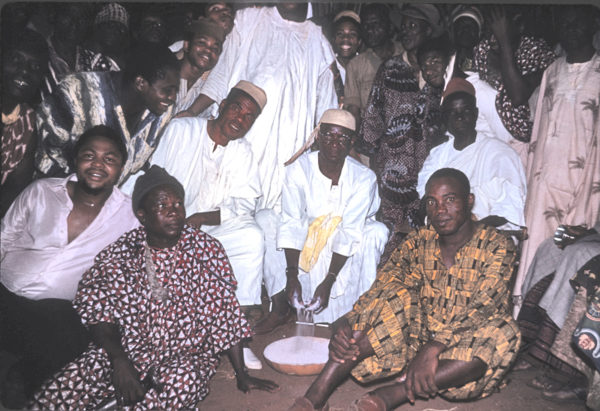
The Obi-elect, dressed in white trousers and a collarless white shirt, wears a white cap into the right edge of which is stuck an eagle feather with barbs slanting downwards and forwards, paralleling his face. He is flanked by Mr. Agunyego, untitled Senior Priest of Oreze (seated to his right), by Barrister Luke Emejulu (now entitled Nnanyelugo), head-cropped in the photo here ( but see below), both also dressed entirely in white, and by Chude the Adazie (head priest of Umu-EzeAroli), also in white but wearing his red chieftaincy cap with a feather in it. With John Ochei and Barrister Emejulu acting as somewhat impromptu Masters of Ceremony, Enwezor is escorted through a series of ritual acts.
Given a calabash filled with powdered white clay, he is directed first to carry it around the arena, throwing some of it outward as he passes, in an initial purification of the grounds (an act John Ochei calls itu-nzu). The Oreze priest then rubs Enwezor’s hands with the white clay, and he is again seated in a folding chair facing the congregation from the end of the arena opposite that where the bottles of drinks are being collected together on a table prior to their presentation before the crowd.
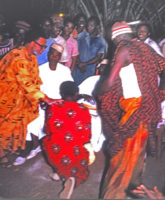
Again flanked on his right by the Oreze priest and on his left by the Adazie, Enwezor sits while each participant who wishes to demonstrate acceptance of his rule approachesd and kneels before him, holding out a pair of cupped hands into which Enwezor pours white powder dipped with his right hand from the calabash. The recipient then rubs his own face and arms with the powder as a sign of acceptance. Meanwhile, Enwezor’s junior brothers, wearing their warrior stocking caps, fire off shotguns as salutes to the Igwe.
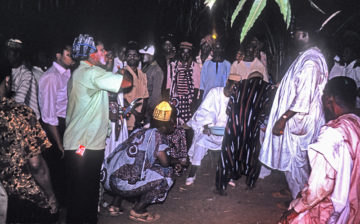
Meanwhile Nnanyelugo Emejulu, also carrying a shotgun, alternates between standing behind the Obi-elect in an imposing posture and moving out among the audience, using his shotgun to push back the photographers who keep crowding forward into the scene.8
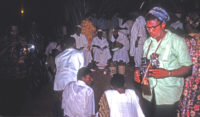
The ritual then follows the standard 1961 Onitsha sequence — presentations of Kola nuts followed by palm wine and then Schnapps — , but at the outset of each phase the photographers rush to the active arena space with flashbulbs popping, while youthful onlookers crowd into the spaces where the candidate and his priests are seated in order to become part of the photographs being taken. Barrister Emejulu begins displaying considerable anger at this disorderly behavior, and various people make repeated demands that the numerous policemen flanking the arena mobilize an effort to move the photgraphers back. The policemen however stand their ground and merely watch the scene. While the kola is being presented, a small fight breaks out when Emejulu leads a charge into the obtrusive ranks of photographers. Eventually the ritual goods are distributed and tempers cool.
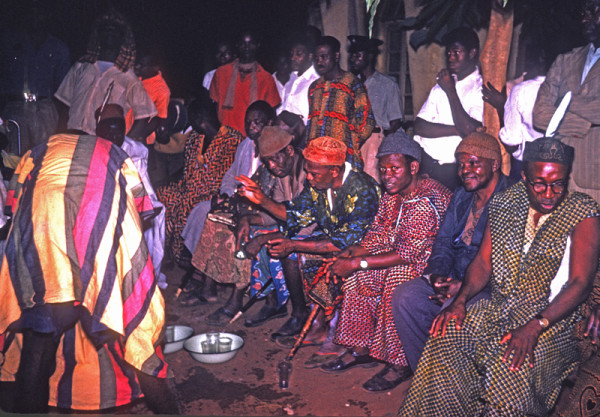
Finally the Senior Priest of Oreze (Anthony Anyaego) makes a brief prayer over the kola, followed by a similar prayer by the Adazie, and while the kola is being broken up for distribution to the crowd, John Ochei performs the traditional dance of joy called ngwadu, in which the dancer, holding his right fist forward at arm’s length with the thumb protruding upwards (a traditional sign of achievement or transcendance), leaps around with great bounding strides, pausing in front of groups of men to balance on his forward right foot (the left being pointed out backward) while bouncing up and down and calling out, “Onicha, kwenu!” (Audience: ehhh!). (I find this remarkable because it is the only occasion I see a version of this traditional dance, frequently performed in ceremonies in the rural areas, done by an Onye-Onicha in 1960-62. Probably a highly traditional form of expression, it is now rare to see in this urban context, yet it is an act of remarkable beauty and grace.)9
By around ll:20 pm, the crowd has grown considerably and youths are present in large numbers as the palm wine distribution begins, followed by beer. The young men continually demand that the assembled photographers take group photographs of them, and most of the photographers are glad to oblige since they can anticipate later sales of their products. One young man begins playing a guitar, and others begin to sing, tapping on beer bottles to beat rhythm.
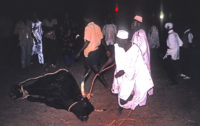
About midnight the Brahma steer is led out into the arena by men wearing Hausa style dress. A circle of youths form around the animal, and they began slapping it violently on its sides, leaping and kicking at it. It is then bulldogged down and the young men pile on top of it. Then, while the photographers maneuver about, one of the Hausa men kneels down holding a knife on the cow’s throat, waits for some pictures, and then quickly slits the throat to a great roar of approval.
The cow is then cut into pieces. As the cutting begins, the legs are severed with the skin still on them; no systematic skinning of the carcass is done.
 While the butcher is doing his work, several of the elderly lineage priests arrange themselves in a small cluster in front of Igwe Enwezor, and the Adazie, seated to his left, prompts one of the Ozo-titled men to remove his cap and to ask Enwezor questions: What he proposes to do when he becomes the Obi, and what his new royal praise name will be. As the titled man stands beside his fellow lineage priests, his cap in one hand, his leather fan and ivory horn in the other, photographers and those hoping to be photographed mill about in the midst of the scene while both Enwezor and the priest remain seated and passively quiet. The Obi-elect does give the praise name by which he wishes to be known: Eze Ndokwa, “King of Peace.”
While the butcher is doing his work, several of the elderly lineage priests arrange themselves in a small cluster in front of Igwe Enwezor, and the Adazie, seated to his left, prompts one of the Ozo-titled men to remove his cap and to ask Enwezor questions: What he proposes to do when he becomes the Obi, and what his new royal praise name will be. As the titled man stands beside his fellow lineage priests, his cap in one hand, his leather fan and ivory horn in the other, photographers and those hoping to be photographed mill about in the midst of the scene while both Enwezor and the priest remain seated and passively quiet. The Obi-elect does give the praise name by which he wishes to be known: Eze Ndokwa, “King of Peace.”
I ask Aniweta about the distribution of the animal, and how many cows Enwezor plans to sacrifice during his installation. He replies that this particular cow will be cut into pieces, roasted, cooked, and eaten here, and that afterward Îgwe will give one cow for each of the Ozo-title-taking complexes in Onitsha. While we speak, Enwezor, now accompanied by Chief (Onoli) Ibeziako, leave the ritual arena and enter Ibeziako’s house where, I am told, he will now get some sleep. The senior lineage priests also depart to their homes, while the remaining young men and a few of the local elite walk about carrying their drinks.
An argument then begins over distribution of the meat. Barrister Emejulu demands that a share of one leg be given to the Onya, and an equal share to the two senior priests (Oreze and the Adazie), the remaining meat to be divided among all present and the innards of the animal to be cooked in a soup to be consumed on the premises. John Ochei, called in to make a decision as the cultural expert, refuses this solution on the grounds that since the leather has been cut to pieces along with the meat there may no longer be a division with shares going to the senior lineage priests; all the meat should be eaten here and now. Ochei wins the argument, but later when he has gone to find more drinks for those complaining of an insufficiency, I see Emejulu walk out to his Dodge with a leg of cow, open the trunk, and drop it in.
I ask Ochei to tell me about the major steps in the ritual and he seems eager to talk. He proceeds with a series of proclamations.
“Udo is a town in Benin. That is where the name comes from. Now, when anyone wants to be Obi, he does not go to Udo, he goes to the [senior priest] of Umu-EzeChima for purification. This land around here all belongs to Oreze, and there is a shrine belonging to Oreze nearby. We all went out early today to this Oreze shrine and worshipped it. The Oreze Diokpala (i.e. Mr. Agunyego), the new Obi, the Diokpala of our family all worshiped there with chalk and palm wine. That is all there is to it.”
Thus he denies the relevance of Udo itself, even though the public announcements have proclaimed this as the ritual being done. In Ochei’s model, the Udo shrine is assimilated to one in the land historically controlled not by Obioo family but by Oreze Family (which includes land recently purchased by Chief Ibeziako). He tells me there is a termite hill on the southeastern portion of the property which Enwezor’s group has visited earlier in the day. Ochei draws a direct comparison between Going to Udo and one’s going to his maximal lineage priest at the culmination of taking the ozo title:
“When one wants to take ozo title he should go to his senior priest, the priest does purification and then he passes the night; just so, when he wants to become King of Onitsha, he should go to Oreze, the Oreze senior priest does the purification and he stays to pass the night.”
Abandoning then the subject of Udo ritual per se, I ask him when Enwezor will be given his ofo, and by whom:
“The bare facts are these: our father came here long before the Ugwu-naObamkpa people, so how could any Ugwu-NaObamkpa man give us ofo? When people came to join Ndi-Onicha, each one gave their ofo to the King; since Ugwu-NaObamkpa people arrived late, they came during the tribal wars, this is why they are called Ekwensu people; how could they as strangers give the staff of kingship to the owners of the land?”
When I ask him if there s no validity to the story of how the Anumudu Family of Umu-Ase obtained the right to bestow ofo to the king, he accepts the story (retelling it quite similarly to the version given by the Family themselves), but argues that “this did not cancel those nine ofo given earlier.”10
In this response Ochei is perhaps conflating the Royal Ofo with the Royal Clan’s Nze staff, or perhaps suggesting that the latter could substitute for the former in the installation process11. He then argues that Umu-Ase are trying to “increase their power in this kingship dispute”, by making the new decision that control over the Royal ofo should rotate among all the major segments, and Ochei argues that in any event their claim to ritual seniority among the non royal clans is invalid; witness (he argues) their position in the prescribed sequence for performing the annual umato ceremony.11
From this case example he moves on to establish what he considers to be the illegitimacy of Umu-Dei as full members of the Royal Clan, arguing this on the basis of the legend about their primordial conflict with Oreze when first crossing the Niger and their subsequent departure to Aboh.12
I record here our discussions in some detail to illustrate the nature of Ochei’s approach to oral history, which represents an extreme form of a general tendency in Onitsha: namely, to adopt in a doctrinaire fashion an equivalent to one fundamental argument of classical British Social Anthropology — that features of belief and custom function to legitimize specific distributions of rights and duties in society. In all of my discussions with him (which began four months prior to the death of the Obi, at a time when no pressing political issues were evident in the situation), he consistently responded to questions about oral history by first emphasizing the substantive right for which (he argued) the narrative sequence established a decisive precedent. While this consideration was undoubtedly a factor in everyone’s recitation of such narratives, very few adopted a so decisively legalistic-instrumental view of historical accounts as did Mr. Ochei (who was known for sitting many hours in various Onitsha courts, imbibing court knowledge). It therefore seems significant to me that he holds this position of the single cultural expert in Enwezor’s group, a “function” that is in contrast shared among numerous people on the Royal Clan Conference side (necessitating negotiation in order to obtain some measure of consensus on what was “traditional”), since it gave him much wider latitudes of creativity in this context.
After long discussions with him, I leave Ibeziako’s premises as the sky is lightening, planning to go home and get my tape-recorder so it can be set up in the Onowu‘s courtyard for the forthcoming Installation ritual scheduled for 8 am, a critical part of which is to be the traditional performing by the Obi-elect of “domestic services for the Onowu”, called ife nru Onowu or odibo onowu. I calculate my time so I can then return to Ibeziako’s to witness the Obi-elect’s return procession from “Udo.” However, my vehicle, the redoubtable “Motor Matches”, broke down along the Oguta road and, unable to get it started again, I had to abandon it and walk home, then hand-carry the tape recorder to the Prime Minister’s house. By the time I arrive there it is too late to make a treck back to Ibeziako’s: numerous cars are already parked outside the Onowu‘s house, people are filling the benches in the courtyard, men from the Eastern Nigerian Broadcasting Corporation are setting up a microphone for broadcasting the event, and I am told that Enwezor would be arriving shortly from Udo.
- See Henderson and Henderson 1966:36 for the traditional significance of this reference, which is roughly “children’s play”. [↩]
- Note this blanket devaluation of women’s roles as polluting, which may shed light on the Prime Minister’s later reference to them in his public speech (Chapter , p. ). [↩]
- Harding 1963:118. [↩]
- Ibid. p. 119. [↩]
- This presumably alludes to the recent court victory by Umu-EzeAroli over Isiokwe in their land case, joining them once again into a single group (and perhaps to future court cases seeking control over other Isiokwe lands. See chapter Four, “Umu-EzeAroli and other Royals“. [↩]
- In fact, I strongly suspect that neither of these events outlined by Mr. Ochei ever occurred in deeds. [↩]
- The first of that American make to be seen in Onitsha. [↩]
- I was of course myself acting as a photographer, but I always tried to avoid injecting myself into the main arena, remaining on an edge where I would physically less disturb the ritual. I seldom received complaints about my behavior in this regard, though I was fittingly sometimes regarded with amusement. [↩]
- And here I fail my duties as photographer, indeed I never managed to get a photograph of Mr. Ochei, definitely a remarkable man and instrumental in guiding Igwe Enwezor’s ritual and other actions. More of his role in various Onitsha activities will be presented elsewhere in this volume. [↩]
- Regarding the previous quotation, his reference is to Ugwu-NaObamkpa connections with hinterland Igbo people. See Henderson 1972:482-3. Regarding the second point, see Ibid. 458-60. [↩]
- See Henderson 1972:267 8. [↩] [↩]
- See Henderson 1972:78 9, 460. This tale is widely told in Onitsha outside the confines of Umu-Dei proper, though not necessarily with any inference of “illegitimacy”. [↩]
